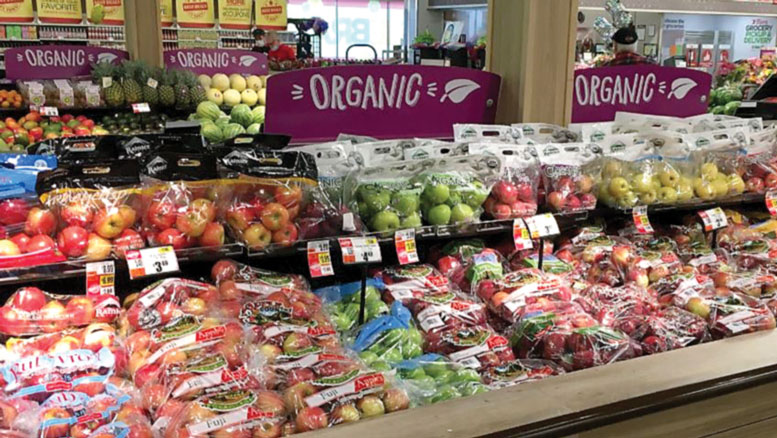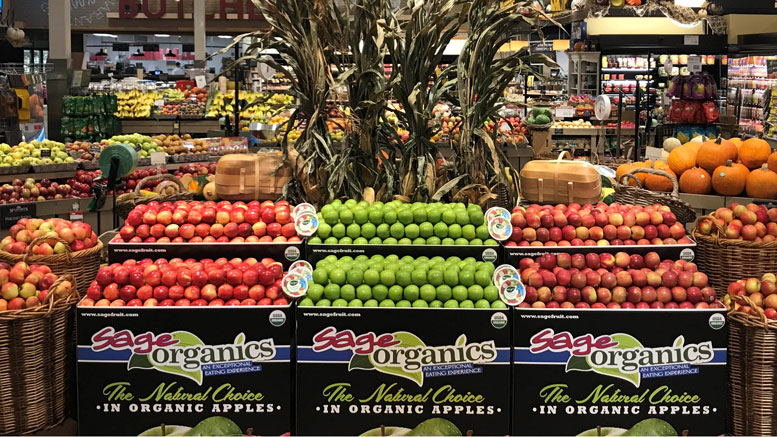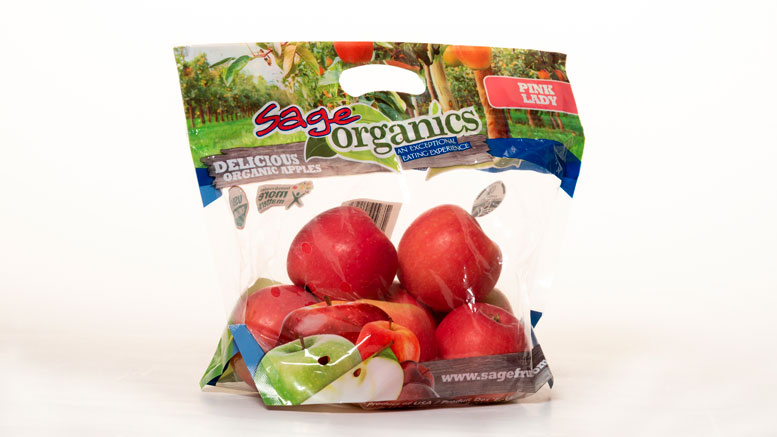Momentum Continues to Build
December 16, 2021 | 8 min to read
Organically grown apples have become essential in produce sales, ranking second only to pre-packaged salads in organic products. Demand for organic apples surged, with sales increasing by double digits. Most U.S. organic apples are cultivated in Washington, where growers have expanded production. Despite challenges like crop diseases, producers in New York and other regions are exploring organic options. Consumers seeking healthier choices are driving this trend, as organic apples typically demand higher prices while maintaining appeal for novelty varieties.

Organically grown apples are a core part of produce sales.
Originally printed in the November 2021 issue of Produce Business.
According to the Washington, DC-headquartered United Fresh Produce Association (UFPA), in its FreshFacts on Retail, Year in Review, organic apples were second only to pre-packaged salads on the Top 10 list of organic products sold in the produce department, with the dollar share of organic produce increasing to 15.6% in 2020. Notably, both dollars (11.5%) and pounds (14.5%) were up double digits.
It certainly looks like organically grown apples are a core part of the apple category and produce department sales.
“Organic apples are a bigger deal now. We’ve seen sustained double-digit growth in the past few years,” says Jeff Cady, director of produce and floral for Tops Friendly Markets, a 157-store chain headquartered in Williamsville, NY.
SUPPLY & DEMAND
According to the 2019 U.S. Department of Agriculture (USDA) Certified Organic Summary, nearly 700 farms in the U.S. produced 831 million pounds of organic apples in that year, and 97% or 805 million pounds were grown in Washington.
“The West Coast has historically been a strong place for organic sales; however, the Northeast and South have made up ground. The Midwest is still a great growth opportunity for organic apples,” says Brianna Shales, marketing director for Stemilt Growers LLC, in Wenatchee, WA. “At Stemilt, about 30% of our entire apple crop is grown and certified organic.”

Many Washington apple growers say organic production represents about 10% of the crop annually. This figure lines up nicely with nationwide sales. Specifically, organic apples represented 8.1% of dollars and 7% of pounds for the 52 weeks ending Oct. 2, 2021, according to data, as provided by New York, NY-headquartered Nielsen.
“We’ve increased our organic apple production over the years with a combination of converting acreage, replanting acreage, and planting organic on virgin soil. As a result, we have a good sustainable supply and we are now almost a year-round supplier of organic apples,” says Mac Riggan, director of marketing for Chelan Fresh, in Chelan, WA.
Increasingly health-conscious consumers continue to drive the demand for organic apples, says Chuck Sinks, president, sales and marketing of Sage Fruit Company, in Yakima, WA.
While retailers nationwide continue to source organic apples from Washington State, growers in other major apple-producing states are looking to get a slice of this pie.
“For years, Eastern growers have committed to IPM and other sustainable growing methods. The biggest problem in New York is scab or black spots from a fungus prevalent in humid climates that disfigures the fruit to the point we can’t even sell it as a misfit,” says Austin Fowler, vice president of sales and marketing at Fowler Farms, in Wolcott, NY, which farms on 2,000 acres, and, of this, 30 acres are certified organic.
Fowler Farms is expanding its test plot acreage by partnering with the organic research orchard at Wegmans Food Markets’ 168-acre farm in Canandaigua, NY. The Rochester, NY-headquartered 106-store supermarket chain operates stores in New York, Pennsylvania, New Jersey, Virginia, Maryland, Massachusetts and North Carolina. In turn, Fowler’s organic apples are sold in the retailer’s produce departments.
“If supply exceeds Wegmans’ demand, we look forward to partnering with other retailers in New York and the Northeast,” says Fowler.
Average retail per pound prices for fresh organic apples were 31.7% higher than their conventional counterparts in 2020, according to UFPA’s FreshFacts.
“Shoppers equate organic with taste. They know organic costs more and are willing to pay more,” says Vince Mastromauro, director of produce operations for Sunset Foods, a 5-store chain based in Highland Park, IL.
Overall, the price gap between conventional and organic produce is beginning to decrease, says Sage Fruit’s Sinks, “at least in our case.”
Cady at Tops Friendly Markets promotes organic apples in a couple of ways. “We’ll do a price-lock program and hold at a specific price for a few weeks. Or we’ll do an organic apple ad and offer more variety,” he says.
CANNIBALIZATION VS. EXPANSION
There is a perceived challenge that organic apples cannibalize sales of conventional apples.
“Some retailers have an organic-first strategy, and that means replacing conventional with organic,” says Fowler.

A migration, rather than replacement, is what Tony Freytag, executive vice president at Cashmere, WA-based Crunch Pak, sees. “As more consumers become aware, as more millennials start to go in this direction, I think we’ll see a generational shift for organic versus a mass movement.”
Organic apples don’t take away from conventional apple sales, says Sage Fruit’s Sinks. “There are consumers for each. Those looking for more affordable, healthy options for their families will continue to purchase conventional apples, while the organic consumer, with a higher income, will fill their basket with multiple organic produce items.”
The availability of organic has brought new shoppers into the category, says Chelan Fresh’s Riggan. “Maybe they are shoppers who don’t eat apples and now they see organic. Or they are hard-core organic shoppers and won’t buy something unless it’s organic and now they see organic apples.”
EVERYDAY & SPECIALTY
Gala, Fuji, and Honeycrisp, in descending volume of production, are the top three varieties of apples for the organic market, according to the report titled, “Apples,” by the USDA’s Agricultural Marketing Resource Center at Iowa State University, in Ames, IA, updated September 2021.
Organic Honeycrisp is a high-end consumer favorite, which has an excellent ring at the register, says Sage Fruit’s Sinks. “On the opposite side of that, though, organic Gala is an excellent option for the everyday, organic consumer because it is more price-friendly.”
The organic shopper is often more experimental and drawn to more specialty or novelty varieties, growers say. Sunset Foods’ Mastromauro sees this echoed at retail.
“Organic shoppers are focused on the good-tasting apples and, instead of looking for the Red and Golden Delicious, are seeking out some of the newer varieties. We’ve carried organic Kiku, Smitten, SweeTango, Kanzi, Pink Lady, and Hidden Rose, which has pink flesh. When the fall harvest kicks in, we’ll expand the variety in organic even more,” Mastromauro says.
Typically, when an apple launches, it will launch conventionally and then certain orchards will start transitioning to organic production so that there are both options for that apple, explains Stemilt Growers’ Shales, who says the grower expects to grow Cosmic Crisp organically.
This marks the third season Dovex will market organic Cosmic Crisp, according to Gene Louden, domestic sales manager for the Wenatchee, WA-headquartered company.
Cosmic Crisp is a cross between Honeycrisp and Enterprise apples bred at the Washington State University Tree Fruit Research and Extension Center, in Wenatchee, WA.
Similarly, Chelan Fresh expects to have better supplies of its Sugar Bee and Rocket varieties for the first time this season.
“Conventional sells well in these two varieties and we think organic will do, too,” says Riggan, who estimates the organic availability of SugarBee and Rockit may last from two, perhaps as long as six months.
BAG VS. INDIVIDUAL APPLES
About 60% of organic apples are sold at retail in bags and 40% bulk. This marks a big shift from just a few years ago, says Stemilt Growers’ Shales. “Over the past 18 months, there has been a double-digit rise in organic apples sold in bags, driven mostly by the COVID-19 pandemic. It’s a combination of factors leading to increased demand for packaged organic apples: consumer desire for no-touch produce, quicker shopping trips where people stock up and enjoy the convenience of bags and the rise in online grocery pick-up/delivery.”
Two-pound pouch bags of Pink Lady, Envy, and Jazz apples sell well at Tops Friendly Markets, says Cady.

Organic apples tend to grow slightly smaller than conventionally grown apples, which allows for more bag opportunities for retailers, says Sage Fruit’s Sinks. Utilizing a combination of both bulk and bagged in the produce department is ideal; some consumers only need a few apples at a time and like to select their own, while others gravitate toward the pre-bagged option.”
LOCAL VS. ORGANIC
Organically grown produce and locally sourced fruits and vegetables are both in demand by consumers.
“We buy organic apples from Washington State, and we promote our locally grown New York apples, too. Locally grown is important due to food miles. If organic apples were available locally, we’d buy them. But that’s tough in our climate,” says Tops Food Markets’ Cady.
Organic and local are two different categories, believes Cynthia Haskins, president, and chief executive officer of the New York Apple Association, in Fishers, NY. “It is not a question of whether one production practice trumps the other. Mother Nature dictates what needs to happen to produce food in a particular region or state.”
New York ranks second in apple production in the U.S. “There is certainly a recognition that organic is important to many consumers, and there are some organic growers in Michigan to fill that niche, but, due to our climate, it is a challenge for many growers to produce organic apples,” says Diane Smith, executive director of the Michigan Apple Committee, in Lansing, MI. “In Michigan, there is a great interest and demand for locally grown produce. Locally grown continues to be successful as a marketing concept for us.”
Lastly, adds the NYAA’s Haskins, “It is not about ‘either/or,’ the connecting word is ‘and’ for local and organic. Let’s focus on increasing consumption of all apples as well as all fresh fruits and vegetables.”
9 of 12 article in Produce Business December 2021

